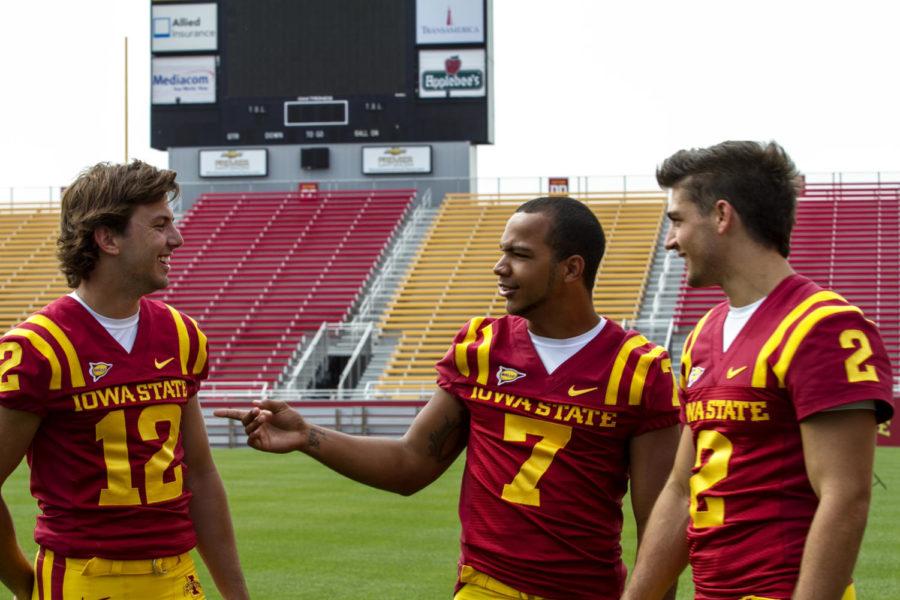Starting quarterback expected to be named Tuesday
August 19, 2012
Heading into the Jacobson Building on Saturday after his team’s final scrimmage of fall camp, Paul Rhoads could have guessed the first question he would be asked by reporters.
“What’s the timetable for selecting a starting quarterback?”
The football coach responded without hesitation: “We’ll get the film thoroughly graded; coaches are going to … sit down and look at the entire camp. Probably by Tuesday at practice we’ll be ready to put somebody in that slot.”
The battle for the most scrutinized position on the field has been in a dead heat between Steele Jantz, Jared Barnett and Sam Richardson through all spring and fall camp.
Last season, Jantz was named the starter ahead of Barnett and Jerome Tiller, who has since switched to wide receiver after being deemed academically ineligible for the 2011 season.
First-year offensive coordinator Courtney Messingham said the offensive staff will be reviewing tape of the quarterback play “with a fine-tooth comb” in order to make a decision.
“It’s also a gut feeling sometimes just with who’s the guy you feel the most comfortable with,” Messingham said. “The hard part with that gut feeling is all of them do things that make you say, ‘Hey, that guy can get it done for us,’ and that’s the exciting part because they have shown that they can get it done.”
Messingham said one of the biggest notes from the quarterback play this fall has been an improved completion percentage from last season, when Jantz completed 53.3 percent of his passes and Barnett completed 50 percent.
However, Rhoads said that may be misleading since the scripted structure of practice may not produce the same results as the raw surface of gameplay.
“The offense one day might have a bunch of plays that are going to work against those defenses called and vice versa,” Rhoads said.
Rhoads did go on to speak with confidence about the completion percentage, however, and said it has been floating around 60 percent for camp.
Jantz had a few things to say as well: “There’s a few things, the first one is getting into the right play, understanding the defense, knowing where to go with the ball. Basically I just try and be perfect with the mental part of the game.
“After that, it’s just fundamentals and being in good rhythm. With all that together, there’s going to be a lot of completions.”
Jantz was the architect behind the team’s triple-overtime upset of arch rival Iowa on Sept. 10, 2011, completing 25-of-37 passes and throwing for 279 yards, four touchdowns and an interception-less performance.
Barnett, however, one-upped Jantz with the biggest upset in school history — a double-overtime victory against No. 2 Oklahoma State on primetime ESPN that eventually spoiled the Comboys’ shot at playing for a national title.
In that game, Barnett completed 31-of-58 passes and threw for 376 yards and three touchdowns.
“Those were all really good team wins and a lot of the losses that we had came from turnovers from the quarterback position, not making big plays from our position,” Barnett said. “As a quarterback group, we have to be more efficient with the ball. We have to make better decisions, we have to make more plays.
“We just have to be all-around better for the whole team.”
In the team’s seven losses last season, the combined quarterback play of Jantz and Barnett yielded a 48.6 completion percentage, three more interceptions than touchdowns and 194 passing yards per game.
Those losses saw numerous big play opportunities go for naught, something the quarterbacks are working on making a thing of the past.
“If you watch, there’s a lot of plays where it’s one little thing keeping us from being successful,” Jantz said. “Instead of a one-yard gain, it might be 12. Instead of a 40-yard incompletion, it’ll be a 40-yard catch.”
Negating the small mistakes will be a big area of focus for this team and for the coaches’ decision to name a starter in time for the season-opening game Sept. 1 against Tulsa.
However, Rhoads said his staffers are ultimately not the ones who will be making the decision on who to start come Sept. 1.
“Decisions are made by the players,” Rhoads said. “They decide on the field with what they put out there and give us a chance to evaluate.
“That part doesn’t necessarily become hard. The fact that they’ve done so many things well together makes it such a close decision.”







